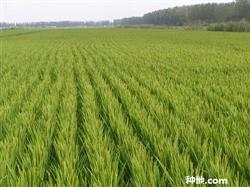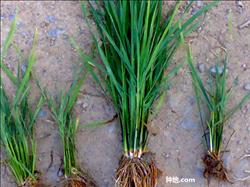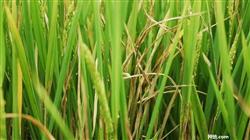How to cultivate Rice well

How to cultivate rice? Please guide if you want to grow rice well, you can refer to the following methods: first, field selection. Choose a blank field with unobstructed drainage and no leakage. Second, broadcast at the right time. The sowing date is late April, and the hybrid rice is sown 1 kg per mu. 80% of the seeds are sown when their breasts are broken and white, which is required to be evenly sown. After sowing, the grain collapsed and the grain was not exposed, so as to improve the seedling emergence rate. Do a good job of thinning and thinning in the three-to four-leaf stage of seedlings. Third, flatten the field. It is required that the field must be leveled and ditched according to the width of the box, which is 20 cm wide and 15 cm deep. After the box is divided, it is flattened with a flat plate on the side of the box, and the seeds are sown after settling. Fourth, rational fertilization. Direct seeding rice must not be partial application of nitrogen fertilizer, the principle of fertilization is "eat less and eat more". 40% compound fertilizer is applied to 35 kg per mu of base fertilizer. The tillering fertilizer per mu was 7.5 kg of potassium chloride, and the seedlings were fertilized with panicle and grain fertilizer in the later stage. Fifth, chemical weeding. 1. Weeding before sowing. For fields with more weeds, 10 days before sowing, when there is no water in the field on a sunny day, spray with 10% glyphosate 1 kg or 41% Nongda 200ml with 50 kg water per mu, or apply base fertilizer in combination with Bian sulfuron per mu, and apply it in front of the field. It can effectively control many kinds of broad-leaved weeds such as Pleurotus ostreatus, Hedyotis diffusa, amaranth and so on. 2. Medication after sowing. Six packets (6 grams each) of wild old brand "Yangbao" were sprayed evenly in each packet of "Yangbao" with water of 10 kilograms and 15 kilograms per mu during the two-leaf and one-heart period of seedlings. The box surface was moist and there was no obvious stagnant water before application. Water must be released back to the field the next day after application, and the normal water layer management in the field should be restored after 5 days. Flooding of seedling heart leaves is strictly prohibited. Sixth, manage water scientifically. After sowing, we insist that the surface of the box is moist without stagnant water, keep flat ditch water in sunny days, not half ditch in cloudy days, and drain water in rainy days. This is conducive to early rooting and early emergence. After the full seedling, the horse water was irrigated in sunny days, and in the period of two leaves and one heart, shallow water was irrigated to promote tillering. Seventh, persist in drying the field ahead of time. Direct seeding rice has early and many tillers, large population and shallow root system, so it should be in advance of drying the field, promote the root system down, reduce the ineffective tiller, increase the panicle rate and prevent lodging. In principle, it is necessary to be "early in the morning" and "double". There are usually three exposures to the field. For the first time, the field is drained and dried on the second day after sowing, and the degree of drying can be controlled as "people walk in the field without trapping feet". As far as time is concerned, it is usually 10 days; the second time is at the end of the tillering stage. when the total number of tillers reaches 90% of the expected number of panicles, the field begins to be ligated when the total number of tillers reaches 90% of the expected panicles, the tillering stage is mainly wet irrigation in shallow water, and the degree of drying is "white roots in the field and chicken claws cracking in the field". Shallow water irrigation is the main irrigation from booting to heading stage, draining and shelving the field in time after milking, "horse racing" water is irrigated in time after the field is dry, dry and wet alternately, and do not irrigate deep water or cut off water too early for a long time. Click to get massive rice planting technology click to get massive grain planting technology
- Prev

How to manage the planting of rape?
How to prevent and cure rice litter disease? Please help rice sitting, that is, rice red blight, which is a common physiological disease in rice production. The disease usually begins about 15 days after planting seedlings. Such as cold wave after planting seedlings, cold soaked field, rotten mud field, deep paddy field, application of unmature organic fertilizer, partial application of elemental chemical fertilizer, lack of potassium.
- Next

Why do rice leaves turn yellow?
Why do rice leaves turn yellow? Please introduce that yellowing of rice leaves is a common phenomenon. The main symptoms are as follows, which should be carefully identified and prevented. 1. Toxic yellowing ① hydrogen sulfide poisoning. The root system is black and smells of rotten eggs, the white roots are few and thin, and the old leaves at the base are yellow.
Related
- The first cup of black tea in spring, the flavor and history of tea gardens in Kenya, Africa
- The computer can not only choose potatoes, but also grow tea rice. AI will grow winter oolong tea champion.
- It is not only the inflated tea bitten by insects, but also engraved with the four seasons tea in Beipu.
- The Oriental Beauty Tea Festival in Zhuxian County takes the stage at the weekend to experience the plus-size feast of oil tea.
- & quot; Oriental Beauty Tea & Exploration of Emei in Hsinchu, the hometown of quot;
- The new variety of strawberry "Tainong 1" dessert is the first choice with mellow aroma. Crimson gorgeous
- History of Tea in Taiwan: from Wild Inner Mountain to Export Tea Garden
- Two types of Taiwan Oriental Beauty Black Tea won the British three-Star Award for Childhood Tea Xiang Zhang Jiaqi changed from pilot to champion tea maker.
- Banana species and varieties: the planting history of Taiwan Xianren banana and dwarf banana is long, is banana disease resistant?
- Coffee planting Technology: Qianjie Coffee from Seedling to harvesting

